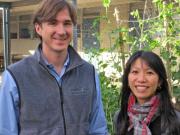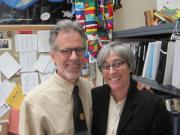Green Schools: Northern California
From my home base in Berkeley I am systematically visiting green schools in Northern California to document best practices. Here are the schools I have visited thus far, in order of appearance: 1. Marin Country Day School, 2. Prospect Sierra School, 3. Castilleja School, 4. Marin Academy.
1. Marin Country Day School: An Inspirational Environmental Community

Walking around the 35-acre campus nestled in a watershed in the Marin County hills with Adam, Facilities Director Dan Carlson, and Environmental Sustainability Director Alice Moore, 

These impressive changes were a direct result of the visionary Strategic Plan adopted by MCDS in 2006 by the Board. They declared: “We want our students to experience joy and wonder in the natural world and to practice sustaining healthy air, water, soil, plans and animals—and healthy bodies.” 
Inspired leaders led change at MCDS. When Lucinda Lee Katz returned to her native Bay Area from the University of Chicago Lab Schools as the Head of MCDS in 2004, she experienced a new “self-awareness” of her “footprint,” changed her own personal practices, embraced the vision of the strategic plan, and led the successful $25 M Capital Campaign and Master Plan to transform the campus. Building her leadership team, she appointed as the new Environmental Sustainability Director science teacher Alice Moore, a Bowdoin College alum who was fresh from the NAIS Sustainability Institute in the summer of 2006. Alice headed up the new Environmental Oversite Committee (EOC) that helped steer the change. Other members of the team include: Mayer Riff, Assistant Head for Finance and Operations, who showed the community that a green campus could save money in the long run; Trustee Julie Parish, a self-described “radical environmentalist,” who co-chairs the EOC; 
MCDS is remarkable among green schools because they have developed a systemic approach to environmental sustainability, one that focused simultaneously on the campus facilities, the curriculum, healthy food, and the entire community’s behavior. What they have accomplished is inspiring.
2. Prospect Sierra School: Empowering Individuals for Sustainability
In the fall 2010 newsletter, Prospect Sierra School Head of School Katherine Dinh wrote a column, “Taking Flight, Let It Roar: Students Finding Their Voices,” to celebrate their student-centered culture. Founded in 1997 as a merger of two private schools in El Cerrito, this K-8 school of 450 students has long been known for its excellence in promoting student achievement and creativity.
According to Katherine Dinh, just last spring the seventh and eight graders at PSS formed one of the country’s first “carrotmobs,” which is a way of encouraging social and environmental responsibility in businesses using positive rewards.
The larger story about Prospect Sierra’s commitment to environmentalism, well told in the PBS documentary “Growing Greener Schools,” is a history of individuals taking action. Ten years ago a new kindergarten parent, Deborah Moore, who worked for the Environmental Defense Fund for twenty years, noticed that her daughter’s school did not seemed as sensitive to the environment as it could be. She helped lead an effort that began with reform of a venerable school institution: pizza day. Students calculated that in just eight days the school generated a ton of waste, presented their findings to the Parents Association, and instituted the school’s first recycling and composting program. Deborah Moore herself then went on to found the Green Schools Initiative to promote environmental sustainability in schools.
Change at Prospect Sierra has been nurtured by many committed individuals. Katherine Dinh herself, described by faculty as a “cutting edge leader,” has encouraged her teachers to innovate and help create a better world. She appointed long-term kindergarten teacher, Kathryn Lee, to a new position as Director of Innovation, Partnerships, and Service. Raised in California’s San Joaquin Valley, Kathryn developed her love of nature spending time on farms, tending the garden, and backpacking in the Sierra.

Prospect Sierra is poised to shape the school’s individual initiatives into a more systemic approach to environmental change. Led by Aaron Morehead, the new Green Council, composed of four faculty, the Facilities and Innovation Directors, and Head of School, is organizing the initiatives related to the campus, curriculum and food program. Once again, individual initiative is propelling important change at Prospect Sierra.
3. Castilleja School: Pioneers in the Field
Five years ago while attending a California Association of Independent Schools professional development meeting, I joined a workshop on green schools. Director of Technology, Steve Taffee, told how Castilleja School, a 7-12 independent girls school of 420 in Palo Alto, had just completed the process to become a green business, one of the first schools in California to be certified.
When visiting the school recently, it was quickly apparent that that pioneering spirit has led to significant environmental initiatives at Castilleja. Now Director of Strategic Projects, Steve Taffee, who came to the school from an educational software company in Silicon Valley, has been joined by a team of talented individuals to effect major changes to the campus itself. 
Strolling the beautiful campus with Superintendent of Buildings and Grounds Dan Chapman, it was apparent that Castilleja has made major changes in the school's facilities by conducting energy audits to improve efficiency and by saving water with a new synthetic field in the center of the campus.
Looking to the future, School Head Nanci Hoffman sees the new Master Plan as a great opportunity to embrace sustainable architectural practices by designing a twenty-first century learning environment using the ideas in Architecture for Achievement: Building Patterns for Small School Learning.
4. Marin Academy--Ecological Mindfulness
Marin Academy--Ecological Mindfulness
When asked how Marin Academy developed its comprehensive approach to becoming a model green school, Mark Stefanski, H.D. Thoreau Faculty Chair for sustainability, has an immediate answer: “We have developed a culture of ‘ecological mindfulness’.” 
Marin Academy has long been known for its excellence in promoting student leadership, and this tradition is evident in the work of the Eco-Council, a group of students, staff, parents and trustees that “promotes a sustainable way of life within our school and neighboring communities.” When I met with the student Eco-Action Team, they were busy planning this year’s Green Week to coincide with Earth Day. 
The students’ environmental consciousness is nurtured by a curricular program that helps them become attuned to nature. Since its founding, Marin Academy has offered a robust Outings Program, one that now gives students a chance to experience nature on weekend trips that include hiking, canoeing, rock climbing, backpacking, scuba diving, rafting, tide pooling, and gleaning. The director Peter Poutiatine himself developed a passion for nature as a kid growing up Marin County, rock climbing on Mt. Tamalpais, as a participant in the National Outdoor Leadership School (NOLS), and now as a keeper for the school’s beehives. 

Tucked away in a back corner of campus, the school’s garden gives students a laboratory to learn environmental principles surrounding food. A Garden Stewardship elective enrolls students to manage the garden, while freshman biology students study composting and organic gardening and English students studying Steinbeck’s The Grapes of Wrath learn what makes topsoil. 
In recent years Marin Academy constructed a number of new buildings including a gymnasium and administration center. In part because their effort preceded the national green building movement spearheaded by LEED and CHPS, they elected not to seek certification, but rather to focus on behavioral changes and energy efficiencies as a first step. Their campus facilities leadership team consists of CFO Mike Joyce, a geologist by training with an MBA from UC Berkeley who previously worked for the Public Land Trust in San Francisco, and Director of Operations, Michael Morris, who provided leadership in hiring Nexant to conduct a comprehensive energy audit to effect change. The question of embracing renewable energy is one that they are addressing.
Looking to the future, School Head Travis Brownley, in her fourth year leading Marin Academy, recognizes the challenge of “sustaining sustainability.” 








